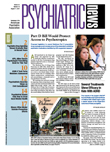Exhaustive neuropsychological testing of a group of healthy children offers a new perspective on cognitive development. The children were tested as part of a National Institutes of Health magnetic resonance imaging (MRI) study of normal brain development in children aged 6 to 18.
“Our goal is to produce a publicly available database of cognitive studies, brain scans, and behavioral and neurological data covering birth to adulthood,” said Deborah Waber, Ph.D., an associate professor of psychology at Harvard Medical School's Department of Psychiatry and at Children's Hospital Boston, in an interview with Psychiatric News.“ We want to describe not the 'normal' brain but rather the healthy brain.”
Children were recruited from 2001 through 2003 at six pediatric study centers in Boston, Philadelphia, Cincinnati, Los Angeles, Houston, and St. Louis. They were evaluated at baseline and at two-year intervals over a span of four years. Data covered subjects who ranged from age 4 to 22. The sample was based on the 2000 U.S census and matched the nation's distribution of income, race or ethnicity, age, and gender. Younger children were slightly overweighted, and older children slightly underweighted in the sample to accrue more children in ages at which rapid developmental changes occur.
Subjects were excluded for a range of criteria related to demographic, medical, behavioral, psychiatric, and neurological factors and abnormalities in pregnancy, birth, or perinatal history.
Children who passed inclusion screening then received a neurological exam, neuropsychological testing, and structural MRI imaging, usually on a single day.
The imaging data from this first round are being analyzed and will be submitted for publication within the next year, said Waber. Data from the second and third evaluations will follow. A similar study of infants and toddlers is also under way, she said.
The subjects were tested for intelligence, processing speed, verbal memory and fluency, spatial short-term and working memory, fine motor dexterity, handedness, executive functions, academic skills, and psychosocial functions.
Overall, this cohort did better than published norms for the tests they were given, probably because potential morbidity was eliminated in the screening process. As might be expected, children from higher-income families performed somewhat better on tests of IQ, externalizing behavior, and social competence than did those from less-affluent families. Income level seemed associated with integrative skills such as reading comprehension and calculation but not with reading single words.
“Income is probably a marker for experience, schooling, and a complex exposure to more words,” Waber told Psychiatric News.
In contrast, scores on the Behavior Rating Inventory of Executive Function were not related to income level, a finding that differed from previous reports and may again reflect the effects of a healthy study cohort, rather than a completely random population sample.
Girls showed better processing speed and motor dexterity, and boys were better at perceptual analysis, again as predicted by earlier studies. However, the girls' advantage at verbal learning declined relative to boys during adolescence, and there was no difference between boys and girls in calculation ability.
Tests that assessed basic information processing increased linearly throughout the age range. However, raw scores in most tests showed that performance improved from ages 6 to 10, but then leveled off between ages 10 and 12. That pattern indicates that children may come close to adult levels in neurocognitive tasks quite early.
The current results are preliminary and cross-sectional, and any conclusions about developmental patterns should be reserved for later in the project, wrote Waber and colleagues in the May Journal of the International Neuropsychological Society.
The study was funded by several branches of the National Institutes of Health, including the National Institute of Child Health and Human Development, National Institute on Drug Abuse, National Institute of Mental Health, and National Institute of Neurological Disorders and Stroke.
